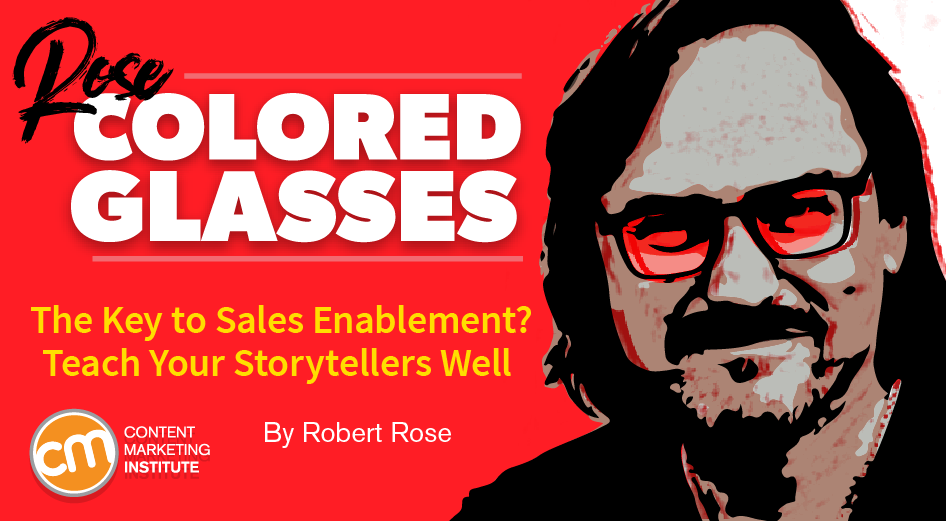MARKETING
The Key to Sales Enablement? Teach Your Storytellers Well

A poor storyteller can kill a great story.
Think of all those great novels that turn into awful movies. Or, that amazing presentation you put together for the CEO who butchered it.
I recently watched a CEO on stage throw his staff under the bus because he didn’t understand the presentation. He started skipping slides and making stuff up. I felt all the feels for the poor team that put in so much work – only to watch it get botched.
A story’s success relies as much on the storyteller as it does on the elements of the story. Sometimes, even more.
For example, I just finished the first season of House of the Dragon. No spoilers ahead, I promise. But here’s the interesting thing: The audience already knows the ending.
House of the Dragon is based on George R.R. Martin’s book Fire and Blood, a companion to A Song of Ice and Fire, also known as the novels that formed the basis of HBO’s Game of Thrones.
Chronologically, Fire and Blood is set some 100 years before the story Game of Thrones. So, Game of Thrones fans have a pretty good idea of how House of the Dragon ends even if they didn’t read the book.
That knowledge puts added pressure on the storyteller, who must find a way to keep the audience interested along the way to that inevitable ending.
A story’s success relies as much on the storyteller as it does on the elements of the story, if not more, says @Robert_Rose via @CMIContent. Click To Tweet
Telling known stories in sales
In sales-enablement content, the audience almost always knows the ending. Every time a sales rep calls, emails, or relays some valuable piece of content, the audience assumes they know how that story is going to end:
- When the content covers an industry challenge, the audience assumes the ending will involve a recommendation that benefits the salesperson’s company.
- With content about a new solution, the audience assumes the content will end with an explanation of why the solution is right for them.
- With customer case studies, the audience assumes the story will end with how well everything turned out for the featured customer.
And they’re right. That’s how all those content pieces will end.
Talk about storytelling pressure.
In sales-enablement #content, the audience almost always knows the ending. That puts a lot of pressure on the storyteller, says @Robert_Rose via @CMIContent. Click To Tweet
How story-storyteller misalignment unites (and divides) sales and marketing
In the latest B2B Benchmarks, Budgets, and Trends research, marketers say their top two challenges are “creating content that appeals to different stages of the buyer’s journey” and “aligning content efforts across sales and marketing.”
I can tell you from my experience with clients that sales teams share those top two challenges. But their frustration isn’t that the content or alignment doesn’t exist. They can’t find the content or figure out how to deliver it to the customer in a helpful way.
On the other hand, marketing professionals think the challenge lies in getting the sales team to use the most current and relevant assets.
Both teams struggle to align the story with the storyteller.
To solve the alignment challenge, content marketing teams must help sales teams become more knowledgeable about and proficient at delivering the most relevant, up-to-date content. Sales teams must agree to participate in training and to use available mechanisms to help them deliver content.
To put it simply: Great content marketing teams create both thought leadership and enablement content that helps sales teams become thought leaders themselves.
Is this training content? Yes.
Is this metadata? Yes.
Are these scripts? Yes.
But more than any of these content types, high-performing organizations need an ongoing process powered by collaborative technology to transform salespeople into powerful storytellers who can deliver a compelling narrative.
The process required involves creating and activating content about the content. It is a functional effort to create thought leadership or marketing materials and portfolios of insight (e.g., a talk track, scripts, deeper meaning behind the numbers, or even instructions on how to talk about the pieces) that enable more intelligent (and compelling) distribution of ideas.
#ContentMarketing teams must create both thought leadership and enablement content to help sales teams become thought leaders, says @Robert_Rose via @CMIContent. Click To Tweet
HANDPICKED RELATED CONTENT:
Storyteller enablement
Many people think of sales enablement content as high-quality content that helps the sales process. So, marketing teams create high-quality, impactful content and make it available to sales teams to distribute when customers or prospects ask for it.
Is it any wonder that modern buyers feel frustrated with sales teams? If a buyer’s conversation features a sales rep offering up a menu of content or asking, “Can I send you some more information?” the conversation is unlikely to end as well as it could. But if the dialogue between the sales rep and the potential customer is consultative, insightful, and helps the customer move their process to purchase along, then successful outcomes are much more likely.
A better form of sales enablement involves teaching salespeople to become high-quality storytellers.
You can begin to do this using three core approaches:
- This might be an ongoing lunch-and-learn series with sales teams or an on-demand set of “classes” on the insightful messaging at each step. Put simply: Get your team and the sales team sharp about the value you need to deliver at each stage of the buyer’s journey.
- Change the nature of the content to enable the customer at each relevant stage. Create a natural exploration journey that goes deeper at each step. In other words, create a progression from “why you should change” to “how you change” and ultimately to “let us help you change.”
- Create ongoing educational assets for every significant piece of content that feeds the sales-enablement process. For example, make sure your content development includes not only a white paper or ebook but also a sales primer on how that ebook (or the major takeaways) should be presented. This step helps the sales team improve their ability to tell the stories you create.
Ultimately, these approaches can become ingrained into the marketing and sales process. And they can provide a feedback loop, too.
As sales teams tell compelling stories, they transform from a simple distribution channel to an insightful listening post. They can feed what they hear in these conversations back to the marketing team so it can develop better content.
When salespeople learn to tell better storytellers, customers may be surprised and delighted even when they know how the story will end. A compelling story well told will show them how their futures can be much better for taking part in it.
It’s your story. Tell it well.
Get Robert’s take on content marketing industry news in just five minutes:
Watch previous episodes or read the lightly edited transcripts.
Cover image by Joseph Kalinowski/Content Marketing Institute



















You must be logged in to post a comment Login